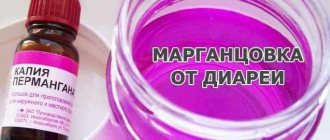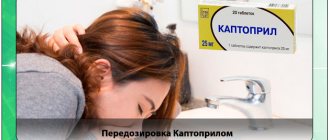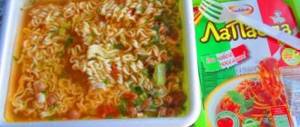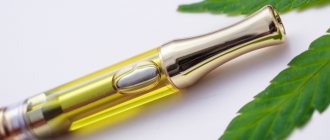Beneficial features
A solution of potassium permanganate has an antiseptic effect in case of poisoning. This effect is achieved due to the release of active oxygen when it comes into contact with organic components. Not every compound can so easily enter into various chemical reactions.
Using potassium permanganate you can effectively rinse the stomach. This manipulation should be done after food poisoning in order to prevent the effects of pathogenic microorganisms on the organs of the digestive system.
The prepared solution has the following effect on the body when poisoning occurs:
- Oxidizes various compounds that are formed in the stomach under the influence of poisoning.
- Kills all pathogenic organisms.
- Causes destruction of cell walls by toxins and microbes.
- Neutralizes chemicals and alcohol substitutes.
- A weak solution of potassium permanganate is an excellent prevention against the development of a purulent infection.
Use of the drug
A weak solution of manganese is used to provide timely assistance in case of severe intoxication of the body
. You can use a low concentration of the drug:
- When do the first symptoms of poisoning appear? The person begins to vomit and feel sick;
- Manifestations of intoxication from low-quality alcoholic products are visible;
- Signs of intoxication with hydrocyanic acid, phosphorus and the alkaloid quinine are noticeable;
After identifying the source of poisoning, experts recommend doing gastric lavage with a weak solution of manganese
. The substance can be used to cleanse the intestinal walls of microorganisms and toxins using an enema.
Potassium permanganate can be used for children only with the permission of the attending physician.
Gastric lavage
Poisoning has a detrimental effect on the human body, because it causes damage to many organs. In this case, a gastric lavage solution can help. This will induce vomiting and cleanse the body of harmful toxins.
How to dilute potassium permanganate? This should be done in a transparent container. Strain the finished solution before using it. If the solution is too strong, it can lead to a lack of oxygen in organs and tissues.
How to dilute potassium permanganate and how to induce vomiting with potassium permanganate? The procedure takes a couple of minutes.
- Take a three-liter jar of water
- Add potassium permanganate (it should say “potassium permanganate” on the package) on the tip of a knife.
- The solution should have a faint pink tint. If the color is too bright, dilute the solution more.
- Drink the diluted drug until you feel like you can vomit.
- If the victim drank the required amount of solution, but vomiting did not occur, it can be induced artificially - to do this, you will have to put two fingers in your mouth and press on the root of the tongue.
Vomiting is not provoked by potassium permanganate, but by a large amount of liquid drunk. The role and function of “manganese” is that the mucous walls are cleansed of chemicals, poisons and harmful toxins.
Can pregnant women drink potassium permanganate if they are poisoned? This question is very relevant today. In fact, pregnancy is not a contraindication to taking the solution. It’s just that today there are more modern drugs that doctors prescribe. If the poisoning occurs suddenly, and there are no modern enterosorbents at hand, then you can use a permanganate solution.
You can learn how to use potassium permanganate in case of poisoning from the following video:
Is it possible to treat a child with manganese?
It is possible to treat a small child in this way, but it is not advisable. Previously, when there were few drugs in the pharmacy to eliminate poisoning, they resorted to a proven remedy like manganese, but now you can buy many drugs for your child that can easily cope with any poisoning without causing damage to the small child’s body.
In any situation, potassium permanganate is a very aggressive oxidizing agent, which even in very small doses is unacceptable for children's use. Moreover, in a home situation it is very difficult to calculate the correct percentage solution. But if in a certain situation, when we are talking about saving a child, and there are no other drugs at hand and the time is running out, you should first of all dilute the permanganate correctly, add 2 crystals of permanganate to one liter of water and let the child drink no more than ½ glass.
It is not advisable to treat a small child with manganese solution
Treatment of diarrhea
Potassium permanganate for diarrhea is the most popular and proven remedy. What to do and what is needed to prepare a solution of potassium permanganate for diarrhea? It is necessary to dissolve the powder in water until a faint pinkish tint is obtained and take it 3 times a day. The dose depends on the patient's age. An adult should consume 200 ml of solution, and a child – 100 ml
Potassium permanganate helps eliminate symptoms such as diarrhea, vomiting, abdominal pain, and bloating. The presented method is considered effective when diarrhea is accompanied by vomiting. You can supplement the treatment with an enema. To administer it, you need to use a syringe with a soft tip. It must be sterilely clean.
Potassium permanganate is an effective remedy in the treatment of various pathologies. It can be used for diarrhea, poisoning, and thrush. A solution of potassium permanganate is used orally, with an enema, and for thrush and genital infections, it is added to the water for washing.
Timing for taking potassium permanganate orally
To eliminate symptoms of intoxication, potassium permanganate is used in cases of food or chemical poisoning. It is important to quickly rinse the stomach with a weak solution to have an astringent effect on the toxic element.
Indications for rinsing:
- alkaloid poisoning: overdose of drugs and drugs;
- poisoning with hydrocyanic acid from food (cherry, peach, peach jam);
- : e-cigarette liquid, childhood smoking;
- fermentation and signs of intoxication: dizziness, abdominal pain, loss of consciousness, high or low body temperature, pale skin with a bluish tint.
Slowly drink 1-2 liters of a weak manganese solution. Wait about 15 minutes to give potassium oxide time to act on protein compounds and “bind” toxic substances. Then induce a gag reflex until a clear liquid appears without inclusions in the vomit. If necessary, repeat the procedure.
Potassium permanganate for poisoning
Our readers successfully use Monastic Tea to treat gastritis and ulcers. Seeing how popular this product is, we decided to bring it to your attention. Read more here...
Potassium permanganate is actively used in surgical, traumatological practice and in case of poisoning. Popularly, this substance is often called potassium permanganate. It is a popular remedy for treating burns, wounds and eliminating the effects of poisoning. Potassium permanganate has become so widely used due to its beneficial effect on the skin and its ability to cleanse the mucous membranes of microbes and harmful toxins.
Potassium permanganate: release form and description
Potassium permanganate is a dry solid consisting of small crystals. They have a dark burgundy color and dissolve well in water. The powder is sold in bottles of 10 grams, less often in bags. If a substance is released in a package, it has no restrictions on its duration. The powder in the bottle must be used within 5 years from the date of production, otherwise it will lose its healing properties. When interacting with the liquid, the crystals give it a bright red color. The solution may change shade and be less saturated. It depends on the amount of water and powder added. If the solution after dilution turns out to be very concentrated, the color of the water will turn dark purple. When applied to the skin, diluted potassium permanganate gives it a brown color.
Areas of use of potassium salt of permanganic acid
Potassium permanganate is an effective remedy for poisoning, but can also be used in various areas.
- Helps determine permanganate oxidation during water quality assessment (for environmental safety purposes).
- Cleans laboratory glassware from various organic compounds and fats.
- Used for toning photographs.
- Acts as an oxidizing agent used to make fireworks.
- Used as a catalyst to decompose hydrogen peroxide in liquid rocket engines (liquid rocket engines) for spacecraft.
- It is used for etching wood in the national economy.
- Helps remove tattoos. Potassium permanganate promotes the death of tissues that have been subjected to chemical burns when the solution is applied to the skin.
- It is often used in medicine in the treatment of urological infections, to eliminate inflammatory processes in women and to combat sore throat, as well as similar diseases. The product acts as a solution for douching and rinsing in gynecological practice.
- Potassium permanganate can be used to treat superficial wounds and lubricate areas of skin affected by ulcers and burns.
Useful properties of powder in case of poisoning
Potassium permanganate has an antiseptic effect due to the release of active oxygen during its contact with organic substances. Few compounds are also able to readily enter into any chemical reaction.
Alternatives
- For foodborne illnesses, you can use EDTA - the additive E-385, best known as the salt of ethylenediaminetetraacetic acid. It is not sold in the public domain, but is actively used for detoxification in clinics and hospitals.
- Another alternative source is antiseptics against intestinal infections. Such drugs have a wide and effective spectrum of action. They quickly relieve all symptoms of poisoning. They are able to directly influence the pathogen.
- For mild intoxication of the body, plant-based antiseptic preparations will help. These drugs include extracts of aloe, fireweed, and chamomile.
How to stop vomiting?
The feeling of nausea and subsequent vomiting is an extremely unpleasant condition for any person, and especially for a child. The reason for its development can be a variety of factors. Profuse and long-term continuous vomiting is fraught with the development of such a serious complication as dehydration. In the absence of timely help, it can lead to very serious consequences, including death.
Potassium permanganate accidentally got into the tank
Let's imagine: the reagent is somehow mixed with fuel. What happens next? Some of the crystals that have slipped through the filter element will give the engine a few extra horsepower by increasing the quality of fuel combustion. But this does not mean that it will be possible to turn a simple car into a sports car. A high concentration of potassium permanganate will cause burnout of the valves. Metal alloys will burn through due to the critical thermal energy generated during the combustion of potassium salt. But salt will not harm the engine of a diesel car.
Characteristics of the substance
Potassium permanganate is a brownish-violet crystalline powder that, when diluted in water, produces a deep burgundy solution. This chemical compound has antiseptic properties and releases oxygen when reacting with organic substances, for example, proteins found in human skin. There are known units of chemical elements that react just as quickly at normal temperatures, like manganese.
Drinking potassium permanganate for various intoxications is useful, as it oxidizes organic and inorganic compounds. This chemical element helps:
- convert some toxic substances into a harmless form, for example, ethanol and various surrogates;
- destroy the cells of many pathogenic organisms that cause food poisoning.
Potassium permanganate quickly causes vomiting and prevents the absorption of toxic substances. If you wash the stomach cavity with a solution of potassium permanganate when the first symptoms appear, you can significantly speed up recovery.
Precautions, expiration date, and how to properly store potassium permanganate
Potassium permanganate is a potent active substance. It is for this reason that it is necessary to store and adhere to all instructions for the duration and use of this drug.
- Be sure to dissolve the permanganate in a transparent container. As mentioned above, a prerequisite is straining through several layers of gauze. In addition, it should be remembered that a saturated solution of manganese that enters the body can cause Met hemoglobinemia, which can lead to a significant lack of oxygen in the tissues and organs of your body.
- The powder must be stored in a tightly closed container away from children. Completely exclude exposure to dampness and sunlight. Shaking the bottle is strictly prohibited; this can lead to self-ignition and even explosion. It is for this reason that potassium permanganate is prohibited from public sale.
- If permanganate is purchased in diluted form, its shelf life is five years. Do not drink this product if the expiration date exceeds the date indicated on the package. Crystals have an unlimited shelf life.
- It is necessary to take into account that external use always leads to a brown coloration of the epidermis. This is normal.
- The strong solution cannot be stored in enamel saucepans or basins, since the prepared product will react with the metal before the expiration date and, accordingly, the medicinal properties will be lost.
- Well, the most important recommendation for the fair sex. Never, under any circumstances, should permanganate be used to terminate a pregnancy. All this can harm the female organs, fraught with serious bleeding, burns, and all this can lead to death.
Almost every patient was exposed to such an unpleasant condition as intoxication of the body. Poisoning can occur from poisons, expired food, or low-quality alcohol. This phenomenon is considered a kind of pathological process, as a result of which poisons and toxins are formed in the patient’s body.
Potassium permanganate in case of poisoning is one of the possible ways to eliminate the first symptoms of the disease.
Manganese, or as it is also called permanganate, potassium permanganate is a powder of a bright lilac hue. The substance contains small crystals. When dissolved in water they form a pinkish solution. Saturation depends on the amount of substance in the water. Potassium permanganate is sold in powder form in bags or immediately in 10 g bottles. The powder, which must be diluted in water, has a limited validity period - no more than one year. The solution can be stored for 5 years. Otherwise, it may lose its medicinal properties. When applied, the drug gives the skin a brown tint.
The solution can have an amazing antiseptic effect
. This reaction occurs through the release of oxygen, which comes into contact with organic substances. These substances include proteins of the human skin. The result is active disinfection. A weak solution of potassium permanganate can be used for poisoning. The interaction reaction will be based on the oxidation of organic and inorganic compounds. The drug is capable of:
- Oxidize compounds formed in the stomach under the influence of poisoning;
- Neutralize chemical elements such as alcohol and its surrogates;
- Used for preventive purposes in case of purulent infection;
- Kill pathogenic organisms by having a destructive effect on their cell wall;
Indications
Potassium permanganate is used not only for medicinal purposes, but also for growing plants and in other areas. Let's consider the main use for medicinal purposes. A weak solution of potassium permanganate is indicated for:
- intoxications caused by low-quality or stale products;
- intoxication with drugs;
- poisoning by toxic plants;
- bathing infants, especially if the umbilical wound is oozing.
They drink the solution both to induce vomiting and during the urge to vomit, in order to thoroughly rinse the stomach cavity. Rinsing is carried out until the waste liquid contains no remnants of undigested food.
A strong aqueous solution is used for treating wounds in traumatology and surgery. A solution of manganese avoids suppuration of wounds and is very helpful in treating even extensive burns.
At home, potassium permanganate solution can be used with great caution, especially for treating children!
Prophylactic use
- As a preventive measure, you can bathe your baby in potassium permanganate when the umbilical wound has not yet healed. Such prevention will help eliminate infection;
- Potassium permanganate is used for balanitis - inflammation of the skin of the genital head of the penis. Potassium permanganate eliminates diaper rash. As a preventive measure after curing the disease, the foreskin and glans are wiped with a cotton swab dipped in potassium permanganate;
- The solution is used for the treatment and prevention of mastitis. To make a healing ointment, beeswax, goose fat, laundry soap, rosin, tar, and potassium permanganate are used. All ingredients are mixed in equal proportions and heated in a water bath. The mixture is used for burns, scratches, and as a preventative against cracking of the skin on the pads of the fingers and toes.
At the moment, potassium permanganate can only be purchased with a prescription.
from the attending physician.
The main reason for restricting free sale was the explosiveness of the substance. If used incorrectly, re-intoxication may occur. But despite this, the drug is one of the best ways to eliminate intoxication in the body. On the recommendation of a specialist, it can be used by both adults and children
. Potassium permanganate is capable of oxidizing compounds and rendering the chemical elements of alcohol and its surrogates inactive.
Widely known among the people, potassium permanganate in some cases can be useful in treating problems caused by alcohol. How to properly use potassium permanganate for alcohol intoxication in the main part of the article.
Contraindications
Potassium permanganate is not recommended for people with individual sensitivity, as well as those who have the following conditions:
- severe skin irritation;
- runny nose of allergic origin;
- bronchitis of allergic origin.
You could say these are just recommendations for some people who suffer from allergies. Manganese is considered one of the mildest antiseptics and, when used correctly, does not pose a danger even to infants.
LiveInternetLiveInternet
Potassium permanganate (potassium permanganate) or simply potassium permanganate has found wide use in medicine as an antiseptic and disinfectant. But besides this, it is used in everyday life for other purposes. Where is it used?
| Answer to the question |
| Where is potassium permanganate used? Potassium permanganate is a unique antiseptic that can be used both externally and internally. It has pronounced antimicrobial (antiseptic) properties, the action of which is based on chemical reactions. In an aqueous solution, in the presence of easily oxidized substances, gaseous oxygen is actively detached from it, which in itself is an effective antiseptic. A solution of potassium permanganate is first aid for human poisoning. A couple of crystals of potassium permanganate are dissolved in a glass of boiled water and this solution is drunk. The source of poisoning has been stopped. To lavage the stomach, you need to drink more liquid to evacuate its contents. The rather specific and unpleasant taste of this solution promotes spontaneous cleansing of the stomach)) It is better to prepare the solution in such a way that there are no undissolved crystals in it that can burn the mucous membranes, namely, it is better to first prepare a saturated solution of potassium permanganate, and then add it to the water and make the required concentration is 0.02-0.1% solution. For diarrhea, you need to drink a solution of potassium permanganate in the morning and evening, but usually 1-2 times are enough for the diarrhea to stop. For open wounds, if there are no other means at hand (iodine, brilliant green, chlorhexidine, hydrogen peroxide), you can wash them with a solution of potassium permanganate. To disinfect superficial wounds, potassium permanganate is diluted in water to the color of thick red wine (about 0.1-0.5% solution is obtained). For minor abrasions, scratches, insect bites, inflammation of the skin (chickenpox, just acne), at the first signs of bedsores, the skin is wiped with cotton wool/rag moistened with a pale pink solution of potassium permanganate, and areas covered with a rash are treated with concentrated 5 % solution. In case of severe skin lesions (chickenpox), to speed up the drying process of wounds and eliminate crusts/sores, you can use baths with a solution of potassium permanganate. But only after the rash (vesicles) stops. First, a highly concentrated solution is prepared, and then it is gradually added to a filled bath of 37 degrees water so that the water turns a faint pink color. And after a bath with potassium permanganate, the skin is rinsed with clean water. For stomatitis and herpes, you can irrigate the affected areas with a weak solution of potassium permanganate (literally pale pink). For sore throat (sore throat, scarlet fever), gargle with a pale pink solution of permanganate several times a day. If foreign objects get into your eyes, if they become inflamed (with the release of pus), you can wash them with a weak solution of potassium permanganate (0.01-0.1%). If you have excessive sweating of your feet, you can take daily foot baths with a pale pink solution of potassium permanganate, and then use special creams, ointments or a 1% formaldehyde solution. If calluses bother you, you can soak your feet in warm water with potassium permanganate, and then in water with salt. The pain will subside a little. If you do such baths regularly, calluses will bother you much less often. Another use of potassium permanganate. It helps heal burn wounds. A strong solution of potassium permanganate (2-5%) is applied to the burned area of skin. The burn goes away faster, but this method is not suitable for all people, because different skin reacts differently to a concentrated solution of potassium permanganate. Potassium permanganate is also used in everyday life. At the dacha, for example. It is effective in controlling pests and diseases of garden and vegetable plants. Disinfecting seeds and soil with potassium permanganate helps fight pathogens that may be present on or inside the seeds, and also protects young plants from pathogens in the soil. In addition, tillage stimulates the processes occurring in the seeds during their growth. Typically, seed disinfection is carried out with a 0.5% solution of potassium permanganate (0.5 grams per half glass of water). The seeds are kept in this solution for a short time, 30 minutes, and then washed in clean water and dried. This treatment increases plant resistance to a number of diseases. To disinfect the soil, before planting seedlings, a solution of potassium permanganate is poured into the wells. The solution is quite weak (about 1.5-2 grams per 10 liters of water). A weaker solution of potassium permanganate (1.5 g per 10 liters) is used against powdery mildew of strawberries and wild strawberries, cucumbers, and melons. Potassium permanganate is added to septic tanks. For disinfection and destruction of bacteria. Use a solution of potassium permanganate to remove cat marks from upholstered furniture and carpets. The principle of action of potassium permanganate is based on its oxidizing ability. But very pale pink potassium permanganate is not as effective in neutralizing odor as, for example, a more concentrated solution. There is also a minus - while neutralizing the odor, it produces an insoluble brown substance during the oxidation reaction. Despite the fact that there are no contraindications for the use of potassium permanganate solution, you must remember that potassium permanganate powder/crystals (if it comes into contact with the skin, and especially the mucous membranes) can cause serious burns. Therefore, when preparing solutions you need to be extremely careful and ensure that the crystals are completely dissolved. |
AND FURTHER.
The extraordinary possibilities of ordinary potassium permanganate
Kutuzov Andrey Ivanovich
Part 1
Medicinal properties
What is potassium permanganate
Potassium permanganate (also known as potassium permanganate, potassium permanganate or KMnO4) is a powder of dark purple crystals. They dissolve well in water, coloring it violet (or pink when highly diluted).
The oxidative properties of potassium permanganate allow it to be widely used in medicine - to destroy infections, to cauterize and dry the skin and mucous membranes. Different purposes require different concentrations of solutions. So, for gastric lavage, make a 0.01-0.1% aqueous solution of potassium permanganate (pale pink), to disinfect a wound - 0.1-0.5% (pink), and to treat burns and ulcers - 2-5 % solution (purple color).
Potassium permanganate, as already mentioned, is often used to wash the stomach in case of acute poisoning. In this case, it is necessary as a disinfectant. The pale pink solution is given to the patient to drink, then he is vomited. However, the unpleasant taste of the drug will “encourage” the patient to spontaneously cleanse the stomach without any extra effort.
ATTENTION
Sometimes it happens that not all potassium permanganate crystals dissolve in water. This can lead to burns to the gastric mucosa. To avoid such consequences, first prepare a concentrated solution of potassium permanganate, and then add a small amount of it to the water for washing. The resulting solution must be filtered.
It is especially important to prepare the solution in this way if it is intended for bathing babies. All mothers and grandmothers know that a bath with a weak solution of potassium permanganate dries out the baby’s delicate skin. The main thing in this matter is not to overdo it and remember: it is not KMnO4 crystals that are added to bathing water, but its solution, so that the water ends up with a pale pink color rather than a saturated one.
A solution of the same concentration is used to wash the eyes for conjunctivitis, to gargle for sore throats and to treat the mouth for stomatitis (inflammation of the tonsils, oral mucosa and gums).
To stop diarrhea, doctors recommend that the patient drink 1 glass of a pale pink solution of potassium permanganate in the morning and evening. Usually one dose is enough for the unpleasant symptoms to disappear.
What causes the amazing healing properties of KMnO4? I will not give a lot of chemical formulas (after all, understanding them also requires preparation), I will try to tell you briefly and in accessible language.
So, what happens when potassium permanganate gets on the skin? At this moment, KMnO4 decomposes with the release of active oxygen. And he, as you know, is the worst enemy of germs and unpleasant odors. That is why in a house where there is a bedridden patient and where the air often becomes heavy and foul-smelling, they put a glass of potassium permanganate diluted to pink: it absorbs unpleasant odors.
Often oxygen is released so quickly that gas bubbles simply do not have time to form. This property, excellent for medicine, allows doctors to inject KMnO4 solutions into deep wounds in case of a very dangerous infection that occurs without access to air.
Potassium permanganate, when decomposing, in addition to oxygen, also releases a brown precipitate of manganese dioxide MnO2. It has an astringent or cauterizing effect, depending on the concentration of the solution. So, for thermal burns, bandages with a cold solution of potassium permanganate are applied to the affected areas. And the stronger the burn, the higher the concentration of the solution should be. Typically 2–5% solutions are used.
Potassium permanganate also helps with snake bites. If there is no special serum, then a KMnO4 solution is injected exactly at the site of the bite. But I will tell you more about this in the relevant sections of the book.
Treatment of other diseases
This short chapter is devoted to diseases that are not included in the previous sections, in the treatment of which, however, potassium permanganate is also actively used.
Sore throat, scarlet fever
Gargling with a weak solution of potassium permanganate is often prescribed for sore throat: 4-5 times a day, and scarlet fever: 3 or more times a day.
A good effect for a sore throat is obtained by alternately rinsing with a pale pink solution of potassium permanganate and a solution of hydropyrite (it is prepared according to the instructions on the package).
Sinusitis
For sinusitis, the nose is washed with a warm pale pink solution of potassium permanganate or water with a small amount of iodine (it is sucked into the nose several times). The procedure is repeated 2-3 times a day.
"Piggy"
Although the disease is considered to be a childhood disease, recently adults are increasingly suffering from it. The fact is that people who were vaccinated against mumps 15–20 years ago have simply lost their immunity against it. Therefore, “children's” infections began to attack adults.
Mumps, like any virus, is accompanied by fever, general intoxication, headache and the main symptom is enlargement of the parotid glands. If treatment is not started in time, the disease can lead to serious complications. After all, while the infection is “walking” in the blood, there is a threat to all organs. Thus, damage to the pancreas can lead to pancreatitis (which, in turn, can lead to diabetes). Or another complication may develop - meningitis, that is, inflammation of the meninges. Therefore, it is very important not to start the disease.
Home treatment for mumps consists of a number of simple procedures. The first and most necessary thing is to rinse your mouth with a pale pink solution of potassium permanganate (cleansing the oral cavity is very important for a speedy recovery). Then they make dry warm compresses on the parotid gland, give the patient vitamins, and at very high temperatures - antipyretics.
For pancreatitis, a strict diet is necessary (or even fasting in the first 2 days). If meningitis has developed, a course of diuretics (diuretics), as well as vitamins and enzymes, is prescribed.
Ingrown toenail
People who are faced with such an annoying problem as an ingrown toenail try in every possible way to avoid it in the future, but, unfortunately, they do not know how.
In this case, surgeons advise eliminating, first of all, the causes of ingrown toenails - tight shoes and improper care of nails (they should only be cut straight and with straight scissors). And at the first symptoms of the disease (pain in the thumb, the appearance of ulcers, blood and pus near the nail), it is necessary to take warm baths with a solution of potassium permanganate. After them, apply a bandage with 10% syntomycin emulsion to the sore finger.
If these measures do not help, you should definitely consult a doctor.
Part 3
Potassium permanganate and plants
The remarkable properties of potassium permanganate - to disinfect and act as an antiseptic - are used not only in medicine, but also in gardening. Our grandmothers also knew: there is no more effective and simple remedy against pests and plant diseases than potassium permanganate!
From a hundred pests
Potassium permanganate contains elements that promote plant growth - manganese and potassium. If you soak the seeds in a solution of potassium permanganate before sowing, this will not only disinfect them, not only destroy pathogens, but also provide a starting supply of manganese. As a result, you can get rich and environmentally friendly products.
In the manuals for gardeners, it is said about potassium permanganate: “A microfertilizer containing manganese is intended for soaking seeds in order to disinfect and reduce plant diseases caused by infections and a lack of manganese-chlorosis on neutral, alkaline and highly calcareous soils. Plants particularly affected by manganese deficiency include beets, potatoes, cucumbers, cabbage, beans, peaches, cherries, plums, apricots, apples and raspberries.”
Potassium permanganate gained the greatest popularity when processing tomato seeds. For 20 minutes, the seeds are soaked in a 0.5% solution of potassium permanganate (0.5 g per 100 ml of water), then thoroughly washed with water and dried.
Onion sets, cabbage seeds, radishes and many annual and perennial flowers are processed in the same way. By the way, the use of potassium permanganate often allows you to do without fungicides.
ATTENTION
As a result of processing, the seeds turn brownish-black. Therefore, there is no need to be scared and think that these are burns.
Potassium permanganate can be used to disinfect the soil in beds, boxes or cups adapted for growing plants. So, seedlings in cups are watered with a warm pink solution of potassium permanganate every 10 days. (Can be alternated with watering with ash lye.)
Before planting the seeds of any vegetables or flowers, water the soil in the box with a special solution: 3–5 g of potassium permanganate per 10 liters of water. This prevents the “black leg” disease of tomatoes, eggplant, peppers, and cabbage.
The same concentration of solution will be needed to disinfect the soil in the greenhouse. 1 liter of solution is poured into the holes for seedlings of tomatoes, cucumbers or other vegetables. However, if you are attentive to your green “wards”, then by their appearance you can almost always determine whether the plant is healthy, and if you notice the first signs of infection, you can immediately take the necessary measures. However, to prevent diseases and the appearance of pests in the greenhouse, “experienced” gardeners treat the outside of the greenhouse several times a season with a 0.5% solution of potassium permanganate. Moreover, not only the walls of the greenhouse are treated, but also the area at the entrance. Gardeners do this unscheduled (and therefore necessarily) when it gets cold after rain.
Fertilizing with a solution of potassium permanganate (3 g per 10 liters of water) increases plant resistance not only to diseases, but also to unfavorable weather.
NOTE
On loamy and peaty soils, manganese promotes the absorption of nitrogen from the soil and helps remove carbon dioxide from the air. Thus, if you treat potato tubers with potassium permanganate, they will become more resistant to scab, and the keeping quality of root crops will increase in winter varieties.
Let's consider the effect of potassium permanganate on the cultivation of some plants separately. And since we started talking about potatoes, let’s continue this topic further.
Potato
North Almost all summer gardeners, preparing potatoes for planting and hoping for more planting material, cut the tubers into segments with “eyes”. At the same time, experienced owners do not forget to treat the cuts with a special product. This is necessary so that the potatoes do not “catch” all kinds of diseases. The sections are disinfected in a simple way: the potatoes are cut with a knife dipped in a solution of potassium permanganate. Then the “wounds” of the tubers are lightly sprinkled with ash.
It must be remembered that cut potatoes, especially on heavy soils, often become infected with a soil infection.
Late blight. Almost every year, potatoes are affected by a dangerous disease - late blight. It appears as large blurry spots on the leaves. To avoid disease, potato tubers are irrigated with a special solution before planting: 10 g of potassium permanganate and 2 g of copper sulfate per 10 liters of water. Use at the rate of 200 ml of solution per 10 kg of potatoes.
Source<https://www.piter-press.ru/attachment.php?barcode=978546901261&at=exc&n=0>
How to prepare the solution correctly
Previously, people did not think much about how to properly dilute manganese, and prepared the solution solely by eye. A pinch of the substance was poured into a container with drinking water and stirred, and then this concentrated solution was poured into the general volume of water for medicinal purposes to obtain a pale pink color.
The potassium permanganate solution must be passed through several layers of gauze or through cotton wool placed in a funnel. This allows you to retain chemical crystals that have not dissolved.
Now little has changed in the method of preparing the healing solution. Add 3-4 crystals per liter of drinking water, which are thoroughly dissolved.
Pharmacological characteristics of potassium permanganate
Potassium permanganate acts as an effective deodorant. When combined with proteins, it releases oxygen, forming a new substance - manganese oxide. Protein structures are destroyed, and when absorbed it has a hematotoxic effect. The property of disinfecting and destructuring proteins has found its application in medicine. Potassium permanganate blocks the poisoning of the body by toxins and prevents the spread of poisons.
It helps to neutralize the toxic effect:
- food products;
- alcohol: high doses or low-quality product;
- quinine;
- morphine;
- hydrocyanic acid;
- nicotine;
- phosphorus.
Once in the body, a weak solution of potassium permanganate blocks the development of fermentation, has an astringent effect, and prevents the spread of toxins.
What happens if you eat dry powder?
If an adult or child eats potassium permanganate in dry form, this can result in severe burns with unpredictable consequences. This usually happens through negligence or for suicidal purposes.
In this case, the person's skin around the mouth is colored and the oral cavity is noticeably colored. The condition deteriorates very quickly, and the following symptoms appear:
- vomit;
- acute pain in the esophagus and stomach;
- burning in the oral cavity, upon examination you can notice burns of the mucous membrane;
- there may be a painful shock.
If a person eats a lot of powder, there may be a perforation of the stomach and severe internal bleeding. If assistance is not provided in a timely manner, death is possible.
You should immediately call an ambulance as soon as the use of dry manganese is discovered. Only doctors can provide qualified assistance to preserve a person’s health and life.
Precautions for taking potassium permanganate orally
Doctors with many years of experience when asked whether it is possible to drink potassium permanganate if poisoned, give ambiguous answers. The usual intake of a weak solution as a drink against intoxication will not give a positive effect. To alleviate the condition, the poisoned person needs to get rid of the poisons secreted by pathogenic microflora.
Contraindications for use:
- allergic reaction to the component: swelling, redness, itching, bloating;
- typological features of the skin and mucous membranes: hypersensitivity, tendency to microtrauma;
- the presence of chronic diseases: rhinitis, bronchitis, asthma.
In any case, before taking it, consult your doctor in advance about using potassium permanganate for treatment. Manganese is considered a gentle agent; it is used in hospitals for poisoning of children in the first year of life. It is important to follow the dosage when preparing the detox solution. An increased concentration causes a burn to the oral mucosa, larynx, esophagus, and stomach walls.
Overdose symptoms:
- burning and sharp pain;
- the mucous membranes of the mouth and throat acquire a purple or brown tint,
- swelling and mechanical asphyxia;
- convulsions and hemorrhagic colitis;
- pain shock.
For children under three years of age, 3 g of the substance is enough to cause death, so it is important to keep the substance out of the reach of children, like other chemicals. Do not leave unattended. For adults, the lethal dose is 0.3-0.5 g/kg.
What happens if you drink a concentrated solution of manganese
There are often cases when, out of ignorance or carelessness, people drink a saturated aqueous solution of potassium permanganate. This can lead to potassium permanganate burns to the mucous membranes of the mouth, esophagus and stomach. To avoid unpleasant health consequences, it is necessary to give the victim plenty of water to drink and periodically artificially induce vomiting. Desoldering continues until the waste water is clear.
If a person drank potassium permanganate and did not vomit, he must wait 15-20 minutes, then let him drink up to a liter of water and induce artificial vomiting by pressing on the root of the tongue.
If a child under 3 years old drinks the concentrated solution, call an ambulance immediately. Such children cannot be induced to vomit artificially at home, as dehydration may occur.
If help is provided on time, there will be no health consequences. But you should still consult a doctor, especially if the victim is a small child or a pregnant woman.
You can often hear advice that egg whites or full-fat milk help with potassium permanganate poisoning. This is completely wrong; in such a case, only clean drinking water will help.
Preparation of a solution for oral administration
Take orally a weak pink solution of potassium permanganate for poisoning, which is safe for the mucous membranes of the mouth, esophagus and stomach. Prepare such a solution yourself, or purchase it from a pharmacy with ready-made medications. The permissible concentration of the active substance is 0.02-0.01%.
Washing is carried out only with freshly prepared manganese.
- to prepare a weak pink solution from powder, just add 1-2 grains of permanganate salts to 1 liter of boiled water. Stir and make sure the water is not brightly colored. If necessary, dilute with more water, reducing the concentration. Before taking, be sure to strain through a layer of cloth or gauze to prevent the ingress of grains of manganese;
- If the medicine cabinet contains a strong solution of potassium permanganate, 1-3% solution, then for rinsing it is diluted at the rate of 3-5 drops of the product per 1 liter of purified water. The reference color remains pale pink. (observe the expiration dates of the concentrate from the pharmacy).
An adult needs to drink 2 liters of rose water; children need 1-1.5 liters. The dose for patients from 3 to 12 years should be reduced. Patients under 3 years of age must undergo gastric lavage in a hospital hospital. A child under three years of age is not able to independently induce a gag reflex, so specialist supervision is important.
What to pay attention to
Potassium permanganate is a fairly aggressive chemical. In order for it to bring only benefit and not cause harm, it is necessary to adhere to a number of rules:
- Prepare the solution only in a glass and completely transparent container so that you can accurately determine the shade.
- Store the package with the substance in a cool and dark place, away from children. It is prohibited to pour crystals from the original container.
- It is forbidden to shake the container with dry potassium permanganate. Doing so may result in fire and explosion.
- Manganese diluted in distilled water can be stored for up to six months. The dry substance has no expiration date.
- It is not recommended to keep the solution in a metal container; due to the chemical reaction, potassium permanganate loses its beneficial properties.
Recently, it is impossible to buy potassium permanganate in a pharmacy without a doctor's prescription. Manganese was classified as an explosive substance and free trade was prohibited. However, this drug is in the home medicine cabinet.
Why you can’t buy potassium permanganate - the main reasons
There are 4 good reasons for the absence of this drug on pharmacy shelves:
- It can be used to make bombs and explosives
- Drug addicts use crystals of the drug as one of the components of the most dangerous narcotic substance - pervitin
- Selling the potassium salt of permanganic acid is inconvenient and unprofitable
- Potassium permanganate is dangerous for consumption - incorrect dosages can cause swelling and burns of the larynx and oral cavity
An explanation regarding the first point - since the substance is truly explosive, it must be stored under certain conditions; not all pharmacies in Russia can boast of this. If a pharmacy premises has a place for storing crystals, which is impregnated with fire-resistant substances, then only by law can it be sold. You should also not display this medication on a counter display.
Explanation regarding the second point - drug addicts have learned to make a narcotic substance called pervitin from potassium permanganate and broncholithin (a cough suppressant that contains ephedrine hydrochloride). In this regard, the authorities had to amend the list of potent narcotic substances and add the potassium salt of manganese acid to it.
An explanation about the third point - if a pharmacy employee sells this drug, then he is obliged to keep strict records of sales. Also, a prescription cannot dispense more than two bottles of medication. Plus, potassium permanganate must be stored in the special conditions specified in the first paragraph (with a fire protection system), and specially installing fireproof protection for the sake of a cheap medicine that is sold in limited quantities is not profitable at all. This is why the drug is so difficult to find.
Symptoms
It is not difficult to identify a burn with potassium permanganate - this requires anamnestic data (the fact of using the drug) and clinical symptoms. The latter are typical for all burns. Based on external signs, the degree of damage can be determined:
- 1 – redness, swelling, burning.
- 2 – blisters on burned skin filled with clear liquid.
- 3 – the contents of the blisters are cloudy or bloody, the formation of a crust (scab).
- 4 – charring of tissues.
Very often there are burns from potassium permanganate in a child, since the skin of children is more delicate and sensitive to chemical damage. Rinsing the mouth with a concentrated solution leads to damage to the mucous membrane with brown-violet erosions. A burn to the esophagus can occur as a result of gastric lavage or ingestion of dissolved potassium permanganate. In this case, there are other symptoms:
- Burning and pain behind the sternum.
- Respiratory disorders (shortness of breath and suffocation).
- Difficulty swallowing (dysphagia).
- Increased salivation (hypersalivation).
- Vomiting blood.
Rinsing the eyes with potassium permanganate can cause burns to the cornea and conjunctiva. This situation is accompanied by pain and pain, lacrimation, spasm of the eyelids and increased sensitivity to light. The mucous membrane swells and turns brown, and the cornea becomes cloudy and rough.
Symptoms of burns with potassium permanganate are similar to signs of injury from other irritating chemicals.
Solution
Sometimes people add manganese to gasoline in an attempt to “annoy” their enemies. If we notice the presence of reagent crystals in the fuel tank of the car, stop using the vehicle and plan your trip in any other way. Once free, choose the most preferable option for yourself:
- remove and then wash the fuel tank;
- purchase special additives that neutralize potassium salt.
Both options are effective. There is only one difference: you will need several hours of free time to dismantle the fuel tank. The tank will have to be removed, washed, and installed back. This work requires some effort. Buying a chemical additive is equivalent to a small cash outlay, but this method does not take time - 20 minutes and the potassium permanganate in gasoline is neutralized. All that remains is to change the fuel filter.
What happens if manganese is added to gasoline? The answer is no big deal. Inspect the fine filter regularly. If small dark crystals are detected, be sure to replace the filter product with a new one.











